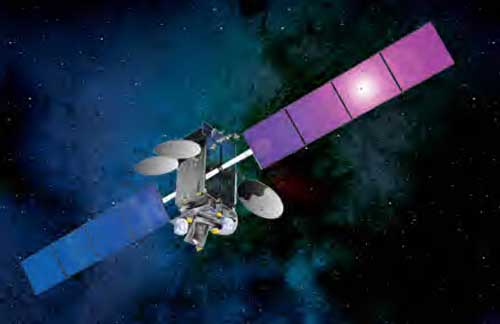The military budget under President Obama and Secretary Gates is dominated by the twin themes of Afghanistan and austerity. The focus on Afghanistan is shaping the strategic perspective for the Administration’s military strategy and austerity is re-shaping the defense portfolios. The power projection forces so dependent upon proprietary military space assets are being significantly re-drawn, less by strategic design than by strategic re-focus.
The impact of the Administration’s decisions and approaches are significant for military space, and is leading to either outright termination of programs, re-shaping programs or putting programs on budgetary diets. The impact is to re-shape military space significantly. This re-shaping is further accelerated by the continued priority placed on the intelligence community’s “black” assets, which may or may not serve well operational deployed power projection forces.
The challenge is how to leverage austerity and the new priorities to re-craft military space. The “strategic pause” being enforced by such actions can provide an opportunity to look at “gapfillers” and “near-term” fixes as key elements for shaping a new space approach which, in turn, can lay the foundation for the launch of new programs on the other side of the Afghan operation. Indeed, the impact of the current strategic review process owes the country more than simply justifications for cancelling programs and supporting counter-insurgency operations. It owes the country some foundational principles for launching a new architecture and new programs to support U.S. and allied power projection forces providing for security and military needs.
Leveraging austerity would start by re-considering the role of the commercial space sector and the changing nature of national security missions. The commercial space sector is viewed by the military space acquisition process as largely a “gapfiller” or “final resort” to provide the data unable to be provided by the preferred proprietary U.S. military systems. Nonetheless, commercial systems will be used more in the next few years due to program terminations and shortfalls in the military space sector.
But a reverse in logic is required. US military space programs should be built with significant commercial space assumed as a core acquisition priority for the US security and military services. The US military space architecture should now be built with a commercial space foundation in place from which unique capabilities would then be defined and prioritized in US military-unique acquisitions. A complete reversal in logic is required: rather than “gapfilling” with commercial systems US military systems would become the unique providers of capabilities UNABLE to be provided by the commercial sector.
Commercial developments make this possible. Notably, hosted payloads provide a significant infrastructure opportunity for the US military to put on commercial satellite buses communications and other assets, which can be launched on a regular commercial launch rhythm. Hosted payloads can provide both test beds for new technologies and augmented capabilities for communications, missile warning and space situational awareness. Commercial operators can field these systems faster (less than three years) and cheaper than dedicated military systems. And such systems can be launched from secure NATO launch range son more than twelve commercial satellites going to GEO each year (from the Cape and French Guiana).
And the change in the focus of US strategy calls for increased use of commercial systems, which can be shared with allies and partners. The purchase of shared assets to support security and law enforcement operations is of increasing significance to the types of operations, which Obama espouses. Whether performing counter-piracy operations, working in joint counter-narcotics operations, whether dealing with environmental threats or challenges, or sharing arms control data, all of this can only happen with the sharing of timely communications and data provided by satellites or other C4ISR systems.
By relying on commercial systems, the ability to share is built in as common decisions can be made about encryption standards for the shared data. If this is not done, the US is left with the very unsatisfactory situation of making case-by-case decisions to share unique proprietary data provided by US military and intelligence satellites. One does not build effective military space architecture on an ad-hoc basis of sharing with allies and partners when you have asserted that working with allies and partners is now the core reality of your strategy.
The new military space architecture would then start by two principles. First, robust acquisition of commercial satellite services would define what the military needs to acquire uniquely. Second, commercial systems would be used widely to allow the kind of sharing required for security and law enforcement operations in which the US will engage in the 21st century.
Additional principles could be added to shaping the new architecture.
The third principle would be to determine what the air-breathing assets already acquired and being acquired provide to the C4ISR architecture of which military space is a key component. The commitment to the F-35 means that a significant ISR capability will be fielded over the next 10-15 years which when joined by unmanned vehicle systems will revolutionize operational ISR. With the addition of stratospheric air vehicles, a significant change in what is required from space can be anticipated.
The fourth principle would be to determine the nature of collaborative space operations with friends and allies. How will US unique systems complement and contribute to the ability to do coalition operations and shape effective global security operations? This means that the US needs to build into the core of its own activities an ability to shape and work with allies in crafting shared and joint collaboration. Notably, the emergence of the European Galileo system at precisely a time when the US is worried about GPS shortfalls suggests that a joint effort would make sense. Collaboration is not the last act of desperation; rather it should become a foundational principle of procurement and operations
The fifth principle would be to determine the unique systems which military space would need to provide in light of the first three principles. With a clear definition of what functionalities are unique, rather than what platforms are unique, commitments could be made for the relatively small number of unique assets, which the US military must own and operate. This would be especially true for a combined naval and air power projection force. The long-range strike and reconnaissance missions which the naval and air forces perform clearly need to be supported by unique US military assets. But rather than defining the architecture largely on the basis of this principle it needs to be the crowing definer of requirements.
Cybersecurity challenges and the threats from some powers who are developing abilities to disrupt US-specific military systems simply re-enforce the advantages of a multi-layered architecture encompassing commercial, air-breathing, allied, and US military systems. The US cannot afford to build a proprietary Pentagon-funded layered and diverse architecture which deal with cybersecurity threats all by itself. A diversified architecture in which commercial and allied elements are part of the foundation makes the task of disruption much harder and certainly for states not terribly desirable politically.
In short, new military space architecture could be built by leveraging austerity. An opportunity exists for the US to move beyond proprietary procurement to a new approach in which unique systems are defined in a new-layered architecture, not as the sine qua non for the Pentagon.
A version of this article appeared in Space News (July 27, 2009).
———-
***Posted September 4th, 2009



